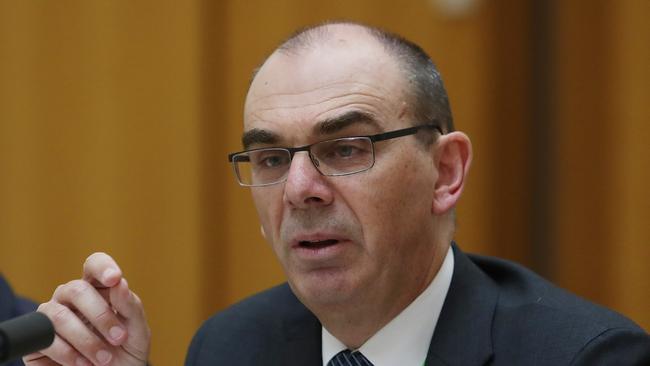APRA issues new warning on climate risks
New draft guidance from Australia’s prudential regulator emphasises the potential for ‘irreversible’ changes in climate.

Business
Don't miss out on the headlines from Business. Followed categories will be added to My News.
The nation’s bank regulator has warned of the unprecedented, far-reaching impact of climate change on all parts of the financial system, putting lenders and insurers on notice they need to be on top of the risks to their businesses.
The Australian Prudential Regulation Authority’s draft guidance on managing the risks of climate change, released on Thursday, highlighted the potential for “irreversible” changes in climate, and effects which were not easily mitigated or reversed.
The risks, it said, could materialise over an uncertain and extended time horizon, beyond normal business planning cycles, and traditional backward-looking risk assessment methods were unlikely to anticipate future events.
APRA chairman Wayne Byres said the regulator had been raising awareness of climate-related risks since the 2016 Paris Agreement, which enshrined the objective of carbon neutrality by 2050.
“Given the unique and long-term nature of the risks, however, processes to measure, monitor and manage climate-related financial risks are still developing,” Mr Byres said.
“The prudential practice guide doesn’t direct or prevent APRA-regulated entities making any particular business or investment decision.
“Rather, it is aimed at ensuring decisions are well-informed and appropriately consider both the risks and opportunities that the transition to a low carbon economy creates.”
Investor Group on Climate Change chief executive Emma Herd said the guidance sent a clear message to directors and trustees that climate risk was financial risk.
“It means assessment, disclosure and management of an organisation’s climate risk exposure is clearly identified as being consistent with proper risk management practices and regulator expectations,” said Ms Herd, who represents institutional investors in Australia and New Zealand with $2 trillion in assets.
“We note that the guidance has been developed in consultation with other Australian financial regulators through the Council of Financial Regulators and APRA’s international peers, which should give it further authority in the market.”
Voluntary disclosure, she said, had made some good progress on addressing climate risk so far.
However, Australian investors had warned it was nnot delivering the rigour and consistency needed by financial markets to fully assess and address climate risk.
With other markets like New Zealand, Britain, Hong Kong and potentially the US moving to mandatory disclosure, Ms Herd said the draft APRA guidance was a good start to moving towards a similar mandatory regime in Australia.
APRA developed the prudential practice guide in response to requests from industry for greater clarity on the regulator’s expectations.

While the guide does not create new requirements or obligations, it covers APRA’s view of sound practice in areas such as governance, risk management, scenario analysis and disclosure.
The regulator said it was designed to be flexible, allowing each institution to adopt an approach for its size, customer base and business strategy.
Release of the practice guide comes ahead of Scott Morrison’s appearance late Thursday at Joe Biden’s climate summit along with 40 other world leaders.
This week, the Prime Minister has announced a $540m investment in developing hydrogen and carbon capture and storage, as well as a $566m international technology package.
However, decisions by the US and Britain to push for more ambitious medium-term emissions reductions targets ahead of Mr Biden’s virtual conference have intensified pressure on Mr Morrison to be more bold than his current pledge to “meet and exceed” a level of emissions which was 26-28 per cent below 2005.
APRA’s practice guide on climate change is aligned with the recommendations from the Financial Stability Board’s Task Force on Climate-related Financial Disclosures (TCFD).
It breaks down climate risk into physical, transition and liability risks.
Physical risks can cause direct damage to assets or property, changes to income and costs, and changes to the cost and availability of insurance, with transition risks covering domestic and international policy reforms, social adaptation and market changes.
Climate change could also give rise to liability risks which have implications for businesses and directors’ duties if institutions and boards fail to consider or respond to the impacts of climate change.
APRA said boards should be able to demonstrate its oversight of climate risks, although certain functions could be delegated provided there was appropriate oversight.
Board-level engagement was key to highlighting the importance of the issue, and gaining sufficient insight so directors could respond strategically.
A prudent board would demonstrate an appropriate level of understanding of climate risks, set clear responsibilities for senior management and hold them to account, re-evaluate the risks and opportunities, take a short and long-term view when assessing risks and opportunities, and oversee compliance with risk exposure limits.
APRA said it expected scenario analysis and stress testing for climate risks to be proportionate to an institution’s size, business mix and complexity.
Larger and more complex institutions, with a wide range of business, would be expected to have more advanced analytical capability.
With increasing demand from investors and other stakeholders for disclosure on climate-related risks, the regulator said lack of absolute certainty on the future impact of climate risks was no excuse to avoid disclosure.
APRA is seeking feedback on the guidance by July 31, with the final guide expected to be released before the end of 2021.
Originally published as APRA issues new warning on climate risks



